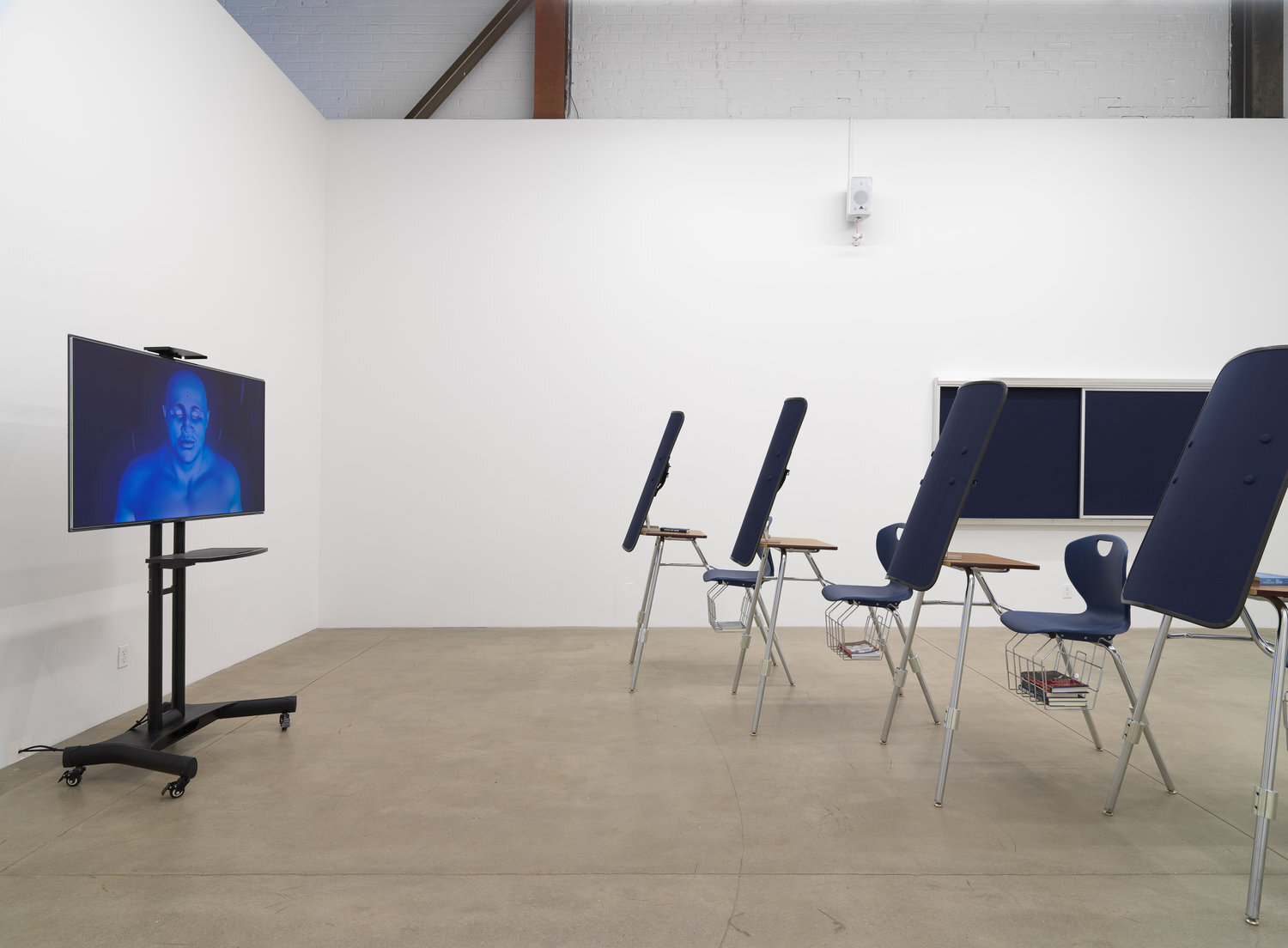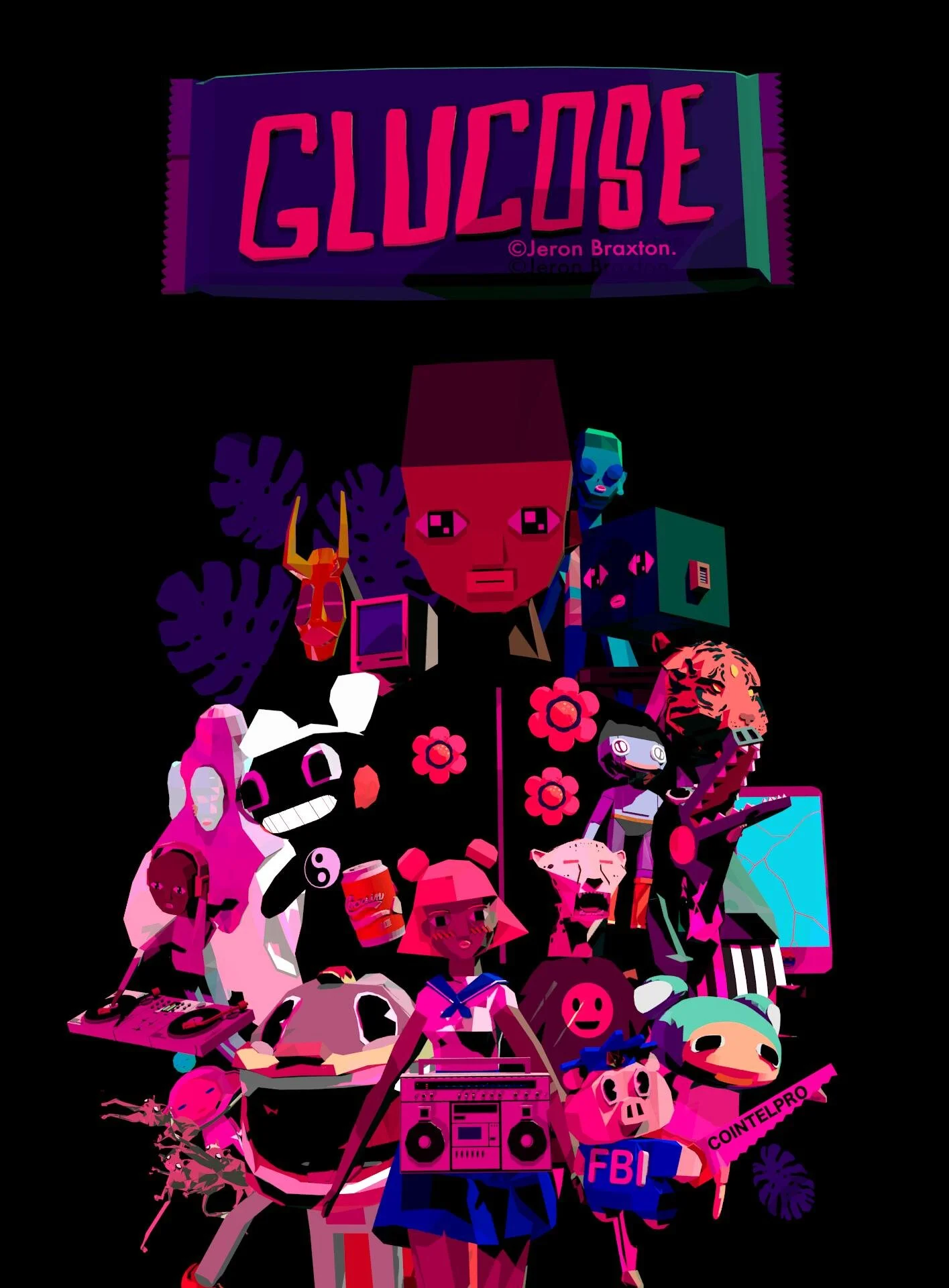My Blue Window
My Blue Window by American Artist is an installation at the Queens Museum in Queens, New York. The installation is a large black room with black walls and a black curtain cutting off a corner of the room. Behind that curtain is a projector and all black bench seats facing the projected screen. The projector is showing a video by American Artist titled 2015. This video shows an imaginary HUD or heads up display on the windshield of a car. The HUD shows target like sights on the screen and a time and date stamp in the bottom right corner. The HUD is an imaginary predictive policing technology. On the other side of the time stamp it will show a crime and a percentage of likelihood that crime is being committed. For example, at one point the HUD shows “burglar” and a “16.1% PCT CHG”. In one scene of the video it shows a flash of purple text saying “Crime Deterred”. In another shot the HUD shows a map of a city cut into many little sections, where a couple of the sections are highlighted purple to represent areas of crime. In the 21 minute video you never actually see a crime or any real evidence of a crime being committed rather just the view through the window of this imaginary police car.
On the other side of the installation by the exit a large LCD TV shows a QR code and a phone. This TV is telling viewers to download the other part of this installation titled 1956/2054. 1956/2054 is an app created by American Artist to collect news about predictive policing, surveillance legislation and other similar topics for its users. The app shows a view similar to one that would be seen in the video. In one corner the app shows a news tab, where users could collect more information about these invasive technologies. Another corner contains a notes tab, where users could write notes about the information collected. This app could be downloaded on android phones.
American Artist is a thirty year old african american artist based out of New York. In 2013 Artist legally changed his government name to American Artist. American Artist works with all media and as a black male many of his pieces explore the idea of race in our modern society. American Artist changed his name to redefine what it means to be an artist in modern america. The anonymity of this name also speaks to an important message in this piece of being able to avoid recognition in a world where systems are trying to identify everyone. As an American black male he see being a white abstract painter as the common stereotype of an American artist and when asked about what it means to be an American artist today he claims “I am American Artist now, so I guess that’s what an American artist is.”. Artist legally changed his name to both avoid the ability to be easily detected by predictive systems and as a statement about modern stereotypes around American artists.
A lot of Artists’ works explore race and identity in modern technology and his race and background has been a big influence on why his pieces explore these ideas. In the past ten years there has been numerous conflicts between police and african american individuals that have been believed to be unjust. One major incident was when a member of the Ferguson police department shot and killed an unarmed black male. This piece is a response to the “Blue Lives Matter” movements that came up after “Black Lives Matter” movements. These major events over the past ten years have also acted as inspiration for American Artist. One major event that influenced this piece was the idea that The New York Police Department would implement predictive policing into their strategies in 2015, hence the title.
Color and the meaning behind colors often play a large part in Artist’s works. The “Blue Lives Matter” movements also had a great influence on this piece. Artist sees this as cops and a community identifying themselves as something similar to how someone from a community of color identifies themselves. The title My Blue Window is directly related to the fact that he created a tool for the police. Artist often uses the color blue in connection with the police in the same way that the police identify themselves as blue. In contrast black plays a large part in this piece. The walls, benches and curtain are all black for a reason. He has this piece surrounded by the community he is a part of. Artist uses color as an important part of their works.
Image courtesy of https://americanartist.us/works/im-blue
The installation I’m Blue (If I Was █████ I Would Die) also by American Artist shares very similar themes in ways similar to My Blue Window. I’m Blue (If I Was █████ I Would Die) was a single room art installation in the Koenig & Clinton gallery. The piece was meant to represent an imaginary police training facility. The room is set up similar to a class room with a TV playing the manifesto of Christopher Dorner. In 2013 Dorner, a former LAPD officer, went on a shooting spree throughout California after believing he was unjustly fired. In this shooting spree it was believed that he was targeting other police officers. This piece was also directly inspired by the racially related events between police and the african american communities. The pieces both use color as a major theme in their names. Both using blue to represent the community of police officers. Both are very speculative about what the future of racism in policing could look like. I’m Blue (If I Was █████ I Would Die) focused more on the issue of opposing communities not recognizing each other as people first. American Artist explores community, racism and policing in very similar ways in these two pieces.
Image courtesy of https://www.dareecejwalker.com/police-cross-lines
Dáreece Walker is another artist who explores similar themes as American Artist. Police Cross Lines by Walker was a series of ten acrylic on vinyl paintings done in 2017. All the pieces follow a very similar theme about the interactions between police and the black community. Some of the pieces show very violent gruesome events between police and someone of color. One example titled, Police Cross Lines 1 - The Eric Garner Lynching, shows the death of Eric Garner by police. Other pieces show the protests that happened in Ferguson, Missouri and the clashes between police and protesters. Walker uses a very different media than Artist but both have very similar influences and overall themes. Artist is also much more speculative and their pieces explore the future of these themes, while Walker’s piece explores the past and how police have abused their powers against the black community. Both artists explore very similar themes around community, racism and police but do it through very different mediums.
My Blue Window has been very successful for American Artist. The pieces gets its viewers whether a part of the african american community or not to think about police the powers and tools they have.
““My Blue Window” reminds us that the police are armed with much more than guns, that armature takes the form of so-called neutral technology, that crime forecasting is the same-old anti-black policing, albeit with shiny new information systems and sophisticated artificial intelligence.”
Tiana explains the purpose of this piece and it is exactly what Artist wanted when creating My Blue Window. With the app American Artist wanted people to not only think about this in the moment but be able to recognize what this issue could look like in the future.
References:
American Artist. “My Blue Window.” American Artist. American Artist, January 7, 2020. https://americanartist.us/works/my-blue-window.
American Artist. “I’m Blue (If I Was █████ I Would Die).” American Artist. American Artist, January 7, 2020. https://americanartist.us/works/im-blue.
Ho, Julie Hoangmy. “Slowing Down to See Black and Blue.” The New York Times. The New York Times, October 23, 2019. https://www.nytimes.com/2019/10/23/arts/design/american-artist-my-blue-window.html.
“Police Cross Lines.” Dáreece J. Walker. Accessed March 16, 2020. https://www.dareecejwalker.com/police-cross-lines.
“Queens Museum.” Queens Museum. Queen Museum . Accessed March 16, 2020. https://queensmuseum.org/wp-content/uploads/2019/02/American-Artist_Press-Release-forweb.pdf.
Reid, Tiana. “American Artist Shows How Tech Trains Us to See the World as Cops Do.” ARTnews.com, November 20, 2019. https://www.artnews.com/art-in-america/features/american-artist-queens-museum-predictive-policing-60221/.
Rinaldi, Ray Mark. “Not Everyone's Going to like Dáreece Walker's in-Your-Face Drawings on Display in Colorado Springs.” The Know. The Know, March 23, 2017. https://theknow.denverpost.com/2017/03/23/force-resistance-drawings-dareece-walker-colorado-springs/139808/.





